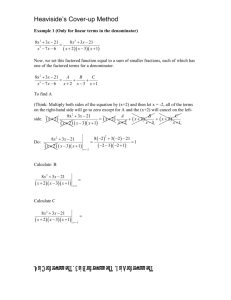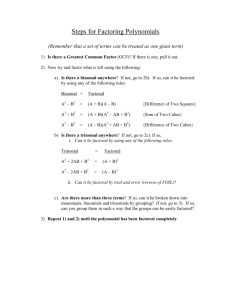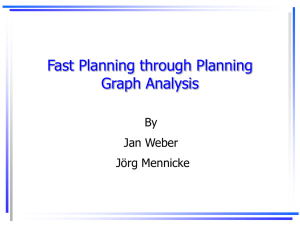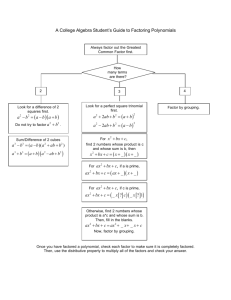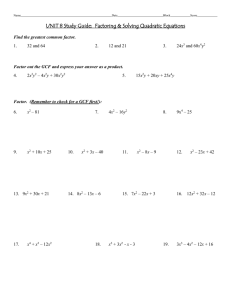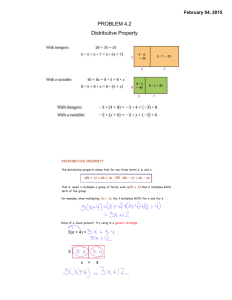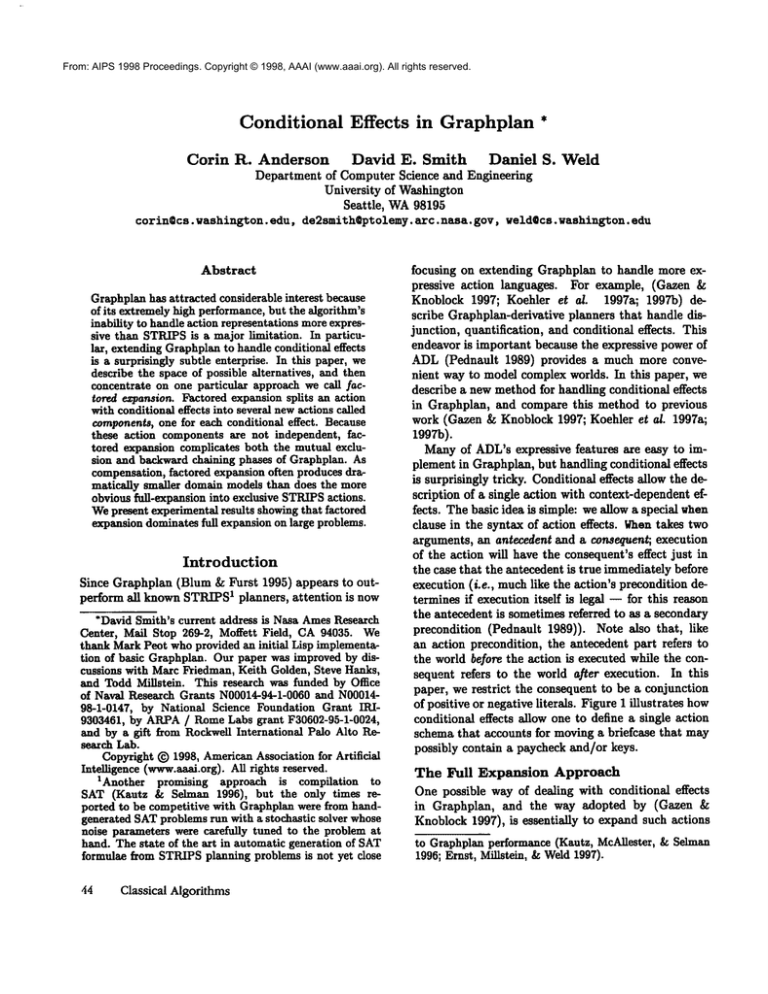
From: AIPS 1998 Proceedings. Copyright © 1998, AAAI (www.aaai.org). All rights reserved.
Corin
Conditional
Effects
It.
David E. Smith
Anderson
in Graphplan *
Daniel
S. Weld
Department of Computer Science and Engineering
University of Washington
Seattle, WA98195
corin@cs,
washington,
edu,de2smithQptolemy,
arc.nasa.gov,weld@cs,washington,
edu
Abstract
Graphplanhas attracted considerable interest because
of its extremelyhigh performance,but the algorithm’s
inability to handle action representations moreexpressive than STRIPSis a major limitation. In particular, extending Graphplanto handle conditional effects
is a surprisingly subtle enterprise. In this paper, we
describe the space of possible alternatives, and then
concentrate on one particular approach we call factored expansion. Factored expansion splits an action
with conditional effects into several newactions called
components,one for each conditional effect. Because
these action components are not independent, factored expansion complicates both the mutual exclusion and backwardchaining phases of Graphplan. As
compensation, factored expansion often produces dramatically smaller domainmodels than does the more
obvious full-expansion into exclusive STRIPSactions.
Wepresent experimental results showingthat factored
expansion dominatesfull expansion on large problems.
Introduction
Since Graphplan (Blum & Furst 1995) appears to outperform all knownSTRIPS1 planners, attention is now
*David Smith’s current address is Nasa AmesResearch
Center, Mail Stop 269-2, Mot~tt Field, CA94035. We
thank MarkPeot whoprovided an initial Lisp implementation of basic Graphplan. Our paper was improved by discussions with Marc Friedman, Keith Golden, Steve Hanks,
and Todd Millstein. This research was funded by Office
of Naval Research Grants N00014-94-1-0060and N0001498-1-0147, by National Science Foundation Grant IRI9303461, by ARPA/ RomeLabs grant F30602-95-1-0024,
and by a gift from Rockwell International Palo Alto Research Lab.
Copyright ~) 1998, AmericanAssociation for Artificial
Intelligence (www.aaai.org).All rights reserved.
1Another promising approach is compilation to
SAT (Kantz & Selman 1996), but the only times reported to be competitive with Graphplan were from handgenerated SATproblemsrun with a stochastic solver whose
noise parameters were carefully tuned to the problem at
hand. The state of the art in automatic generation of SAT
formulae from STRIPSplanning problems is not yet close
Classical Algorithms
focusing on extending Graphplan to handle more expressive action languages. For example, (Gazen
Knoblock 1997; Koehler et al. 1997a; 1997b) describe Graphplan-derivative planners that handle disjunction, quantification, and conditional effects. This
endeavor is important because the expressive power of
ADL(Pednault 1989) provides a much more convenient way to model complex worlds. In this paper, we
describe a new methodfor handling conditional effects
in Graphplan, and compare this method to previous
work (Gazen & Knoblock 1997; Koehler et al. 1997a;
1997b).
Manyof ADL’sexpressive features are easy to implement in Graphplan, but handling conditional effects
is surprisingly tricky. Conditional effects allow the description of a single action with context-dependent effects. The basic idea is simple: we allow a special when
clause in the syntax of action effects. Whentakes two
arguments, an antecedent and a consequent; execution
of the action will have the consequent’s effect just in
the case that the antecedent is true immediately before
execution (i.e., muchlike the action’s precondition determines if execution itself is legal -- for this reason
the antecedent is sometimesreferred to as a secondary
precondition (Pednanlt 1989)). Note also that, like
an action precondition, the antecedent part refers to
the world before the action is executed while the consequent refers to the world after execution. In this
paper, we restrict the consequent to be a conjunction
of positive or negative literals. Figure 1 illustrates how
conditional effects allow one to define a single action
schema that accounts for moving a briefcase that may
possibly contain a paycheck and/or keys.
The Full Expansion
Approach
One possible way of dealing with conditional effects
in Graphplan, and the way adopted by (Gazen
Knoblock 1997), is essentially to expand such actions
to Graphplan performance (Kautz, McAliester, & Selma,
1996; Ernst, Milistein, &Weld1997).
io~l-hrie|cue
(?loc
?new)
2 reserved.
From:
AIPS 1998
Proceedings.
Copyright © 1998, AAAI (www.aaai.org). Allcase
rights
is 2"m. This
:~ec (and (at b~iefcase ?loc) (location ?now)
(not (- ?loc ?new)))
:effect (mad (at briefcase ?new) (not (at brisfcue ?loc))
(when (in paycheckbriefcase)
(and (at paycheck?new)
(not (at paycheck?loc))))
(when (in keys briefcase)
(and (at keys ?new)
(not (a~ keys ?loc)))))
Figure 1: Conditional effects
allow the same
move-briefcase operator to be used when the briefcase is empty or contains keys and/or paycheck.
into several independent STRIPSoperators. As an example, the action schema in Figure 1 could be broken
up into four separate STBIPSschemata (as shown in
Figure 2): one for the empty briefcase, one for the
briefcase with paycheck, one for the briefcase with
keys, and one for the briefcase with both paycheckand
keys.
move-briefcase-enpty
(?loc ?nee)
:larec (and (at ~ielcase ?loc) (location?new)
(not (- ?loc ?new))
(not (in paycheck briefcase))
(not (in keys briefcue)))
:effect (and (at b~iefcase ?new) (not (at briefcase ?loc)))
novs-b~iefcaoa-pnycheck (?loc ?new)
(and (at briefcase ?loc) (location ?nee)
:l~rec
(not (- ?Ioc ?new))
(in paycheck briefcase)
(not (in keys briefcase)))
:affect (and (at brie~case ?~en) (not (at hziefcue ?leo))
(at paycheck ?new) (not (at paycheck ?loc)))
move-brlefcase-keys
(?loc ?new)
:larec (and (at l~cielcase?loc)(location?new)
(not (- ?loc ?new))
(not (in paycheck~rlefcase))
(in keys briefcue))
:effect(o~xt (st t~clefcnae?nov) (not (st briefcase?Ioc))
(at keys ?new) (not (at keys ?loc)))
move-b~riefcase-hoth (?loc ?new)
(and (at briefcase ?loc) (location ?nea)
:prec
(not (- ?loc ?new))
(in paycheck briefcue)
(in keys briefcase))
:effect (and (at ~lefcase ?new) (not (at briefcale?loc))
(at paycheck ?new) (not (at paycheck ?loc))
(at keys ?~v) (not (at keys ?lee)))
Figure 2: The four STRIPSoperators for moving the
briefcase.
Thetrouble with this approachis that it can result in
an explosion of the numberof actions. If a book could
also be in the briefcase, eight action schemata would
be required. If a pen could be in the briefcase, sixteen action schemataare required, and so forth. More
generally, if an action has n conditional effects, each
with m conjuncts in its antecedent, then the number
of independent STRIPSactions required in the worst
explosion frequently occurs with
quantified conditional effects. For the briefcase we really want to quantify over all items in the briefcase
as shownin Figure 3. In essence, this operator has
one conditional effect for each item in the briefcase.
If there were twenty items that could be in the briefcase, full expansionwouldyield over a million STRIPS
operators.
move-briefcase (?loc ?nee)
:~sc (and (st b~i~cuo ?loc) (location
?now)
(not (= ?loc ?new)))
:effect (ud (at b~iefcase ?nee) (not (st briefcase ?loc))
(forallTi (vhas (in ?i briefcase)
(end (at ?i ?new)
(not (at ?i ?loc))))
Figure 3: A quantified conditional operator for moving
the briefcase.
The Factored
Expansion
Approach
A second possibility for dealing with actions with conditional effects, and the one we concentrate on in this
paper, is to consider the conditional effects themselves
as the primitive elements handled by Graphplan. In
essence, this makesall effects be conditional. For ex
ample, the action schema in Figure 1 would be interpreted as shownin Figure 4.
nove-~iefcue (?loc ?now)
:effect (when (a~ (at briefcase?ioc) (location
(not (- ?Ioc ?new)))
(aA (at. bzie~case ?nsi)
(not (at b~iefcase ?1oc))))
(when (and (at brle~case?lec)(location.~aew)
(not (- ?ioc ?nov))
(in paycheckb~ie~ca~e))
(and (at paycheck ?new)
(not (at paycheck ?loc))))
(when (and (at b~iefcaas?loc) (location?new)
(not (- ?loc ?nov))
(in keys briefcase))
(and (at keys ?nov) (not (at keys ?loc))))
Figure 4: Fully conditionalized schema for moving a
briefcase.
The advantageof this "factored expansion"is an increase in performance. By avoiding the need to expand actions containing conditional effects into an exponential numberof plain STRIPSactions, factored
2The numberof antecedent conjuncts, m, participates
in the exponentbecausethe behaviorof the action varies
as a functionof eachconjunct-- if anyoneconjunctis false
then the correspondingeffect is inactive. Theworst case
comesabout if all nmpropositions are distinct in which
case all combinationsmust be enumerated.The 2"mnumber can actually be reducedto nmas explained in (Gazen
&Knoblock
1997), however
this is still verylarge.
Anderson
45
From:
AIPS 1998
Proceedings.
Copyright
© 1998,
expansion
yields
dramatic
speedup.
ButAAAI
this(www.aaai.org).
increased All rights
for reserved.
plan existence.
performance comes at the expense of complexity:
Because factored expansion reasons about individual
effects of actions (instead of complete actions), more
complexrules are required in order to define the necessary mutual exclusion constraints during planning
graph construction. The most tricky extension stems
from the case when one conditional effect is induced
by another .... i.e., whenit is impossible to execute
one effect without causing the other to happen as
well.
¯ Factored expansion also complicates the backward
chaining search for a working plan in the planning graph because of the need to perform the
analog of confrontation (Penberthy & Weld 1992;
Weld 1994), i.e., subgoal on the negated preconditions of undesirable conditional effects.
The IP 2 Approach
A third possible method for handling conditional effects is employed by the IP2 planner (Koehler et al.
1997b). The IP2 system sits halfway between the full
and factored expansion methods, using techniques sim2ilar to both. A more thorough discussion of the IP
system is made in the empirical results section, after
the requisite Graphplan background is discussed.
Overview
In the next section we briefly review the basic Graphplan algorithm and extend it to handle negated preconditions and disjunction; these extensions are necessary
for handling conditional effects. Following the Graphplan background, we give a detailed development of
our factored expansion approach with illustrative
examples. Next, we present empirical evidence that factored expansion yields dramatic performance improvement over full expansion. Finally, we offer some discussion of related issues and work and give concluding
remarks.
Graphplan
Background
Webriefly summarizethe basic operation of the Graphplan algorithm as introduced in (Blum & Furst 1995;
1997). Graphplan accepts action schemata in the
STRIPSrepresentation -- preconditions are conjunctions of positive literals and effects are a conjunction
of positive or negative literals (i.e., composingthe add
and delete lists).
Graphplan alternates between two
phases: graph expansion and solution extraction. The
graph expansion phase extends a planning graph until
it has achieved a necessary (but insufficient) condition
46
Classical Algorithms
The solution extraction phase performs a backward-chaining search for an actual solution; if no solution is found, the cycle repeats.
The planning graph contains two types of nodes,
proposition nodes and action nodes, arranged into levels. Even-numberedlevels contain proposition nodes,
and the zeroth level consists precisely of the propositions that are true in the initial state of the planning
problem. Nodes in odd-numbered levels correspond to
action instances; there is an odd-numbered node for
each action instance whose preconditions are present
and are mutually consistent at the previous level. Directed edges connect proposition nodes to the action
instances at the next level whose preconditions mention those propositions. And directed edges connect
action nodes to subsequent propositions made true by
the action’s effects.
The most interesting aspect of Graphplan is its use
of local consistency methods during graph creation -this appears to yield a dramatic speedup during the
backward chaining search. Graphplan defines a binary
mutual exclusion relation ("mutex") between nodes
the samelevel as follows:
¯ Twoaction instances at level i are mutexif either
- Interference / Inconsistent E~eeta: one action
deletes a precondition or effect of another, or
- Competing needs: the actions have preconditions
that are mutually exclusive at level i - 1.
¯ Twopropositions at level j are mutex if all ways of
achievingthe propositions (i. e., actions at level j - 1)
are mutex.
Suppose that Graphplan is trying to generate a plan
for a goal with n conjuncts, and it has finally extended
the planning graph to an even level, i, in which all
goal propositions are present and none are pairwise
mutex. Graphplan now searches for a solution plan
by considering each of the n goals in turn. For each
such proposition at level i, Graphplan chooses an action a at level i - 1 that achieves the goal. This is
a backtracking choice- all possible actions must be
considered to guarantee completeness. If a is consistent (non-mutex) with all actions that have been chosen so far at this level, then Graphplan proceeds to
the next goal, otherwise if no such choice is available,
Graphplan backtracks. After Graphplan has found a
consistent set of actions at level i - 1 it recursively
tries to find a plan for the set of all the preconditions
of those actions at level i - 2. The base case for the
recursion is level zero -- if the propositions are present
there, then Graphplan has found a solution. If, on the
other hand, Graphplan fails to find a consistent set of
From:
AIPSat1998
Proceedings.
© 1998, is
AAAI
(www.aaai.org). All rights reserved.
actions
some
level andCopyright
backtracking
unsuccess-
1. C1 has antecedent p and consequent e.
ful, then it continues to alternate between growing the
planning graph and searching for a solution (until it
reaches a set limit or the graph levels off).
Negated
and Disjunctive
Preconditions
Although methods for handling negated and disjunctive preconditions were not presented in (Blum & Furst
1995), they are both straightforward and essential prerequisites for handling conditional effects. Clearly
proposition p and -~p are mutually exclusive in any
given level. Whenever an action instance deletes a
proposition (i.e. has a negated literal as an effect), one
must add that negative literal to the subsequent proposition level in the planning graph.
Disjunctive preconditions are also relatively easy.
Conceptually, the precondition (which may contain
nested ands and ors) is converted to disjunctive norreal form (DNF). Now when the planning graph
extended with an action containing multiple disjuncts,
an action instance may be added if any disjunct has
all of its conjuncts present (non-mutex) in the previous
level. During the backchaining phase, if the planner
at level i considers an action with disjunctive preconditions, then it must consider all possible precondition
disjuncts at level i - 1 to ensure completeness.
Conditional-Effects
Graphplan
The central concept of the factored expansion approach
to handling conditional effects is that of an action component. Formally, a componentis a pair consisting of a
consequent (conjunction of literals) and an antecedent
(disjunction or conjunction is allowed). An action has
one component per effect (where effect is defined in
(Penberthy & Weld 1992, Section 2.3)). A component’s antecedent is simply the action’s primary precondition conjoined with the antecedent of the corresponding conditional effect; a component’s consequent
is simply the consequent of the corresponding condiational effect,
Using this approach, every ordinary STRIPS action would have only one component. However, actions with conditional effects would have one component for the unconditional effects, and one component
for each conditional effect. As an example suppose
that action A has precondition p and three effects e,
(when q (f -~g)), an d (when (r A s) -~q). Thi
tion would have three components:
s Just as it is useful to considerlifted action schematain
addition to groundactions, we will consider lifted component schemata as well as ground components.Unless there
is somepotential confusionwe shall call both the lifted and
ground versions components.
2. C2 has antecedent p A q and consequent f A -19.
3. C3 has antecedent p A r A s and consequent ~q.
Revised
Mutex Constraints
For the most part, graph expansion works in the same
manner as in the case of STRIPSactions, except at
odd-numbered levels, we add instances of components
instead of action instances. An instance of component
Ci is added when its antecedents are all present and
pairwise non-mutex at the previous proposition level.
For example, if p and q are the only literals present in
level i - 1, then level i wouldcontain an instance of C1
and C2 (but not C3). Whena component is added
an odd-numbered
level,thenits consequent
is added
to thesubsequent
levelin theobvious
way.Thus,in
ourexample,e and f and-~g wouldallbe addedto
level
i + 1.SeeFigure
6.
So far,thisis straightforward,
butthehandling
of
mutexconstraints
isactually
rather
subtle.
Recall
that
mutexconstraints
aredefined
recursively
in termsof
theconstraints
present
at theprevious
level.
Thedefinition
forproposition
levels
is unchanged
fromvanilla
Graphplan:
¯ Twopropositions p and q at level j are mutex if all
ways of achieving p (i.e. all level j - 1 components
whoseconsequents include p as a positive literal) are
palrwise mutex with all ways of achieving q.
There are two changes to the definition of mutex
constraints for components. The interference condition (originally defined in the Graphplan Background
section) has an extra clause (so it implies fewer mutex
relations), and there is also a new way of deriving
mutex relation, the induced component condition:
¯ Two components Cn and C~ at level i axe mutex if
either:
- Interference / Inconsistent Effects: components
Cn and Cmcome from different action instances
and the consequent of componentCn deletes either
an antecedent or consequent of Cm(or vice versa),
or
- Competing Needs: C, and Cm have antecedents
that are mutexat level i - 1, or
- Induced component: There exists a third component Ch that is mutex with Cmand Ck is induced
by Cn at level i (see definition belowand Figure 5).
Intuitively, componentC,~ induces Ck at level i if
it is impossible to execute Cn without executing Ck;
more formally, we require that:
Anderson
47
From: AIPS 1998 Proceedings. Copyright © 1998, AAAI (www.aaai.org). All rights reserved.
Level
i-1
Level
i
q
Leveli+1
q
C,.
s
Figure 5: If Cn induces Ck and Ck is mutex with Cm,
then Cn is also mutex with Cm.
1. Cn and Ck derive from the same action schema with
the same variable bindings, and
2. Ck is non-mutex with Cn, and
3. the negation of C~’s antecedent cannot be satisfied
at level i - 1. In other words, suppose that the antecedent of Ck is Pl A ... A P6, then we require that,
for all j, either -~pj is absent from level i - 1 or -~pj
is mutex with a conjunct of Cn’s antecedent.
Wenow discuss in more detail the two differences
between our definition of mutual exclusion and the definition used by vanilla Graphplan.
Interference Our first change to the mutex definition reduces the number of mutexes by adding a conjunct to the interference clause. This is because actions often clobber their own preconditions. For example, one can’t put one block on another unless the
destination is clear, yet the act of putting the block
down makes the destination be not clear. This selfclobbering behavior doesn’t bother Graphplan (because a STRIPSaction’s effects are never compared
to its preconditions), and our modification of the interference condition is simply a small generalization
to ensure that there is no problem (i.e. no mutex constraint generated) when one conditional effect clobbers
the antecedent of another conditional effect of the same
action. (Note that this generalization is only necessary
for factored expansion -- if full expansion is used, the
vanilla definition of interference is fine.)
Induced components Our second change to the
mutex definition is an optimization that increases the
number of mutexes through the notion of induction.
A few examples will make the definition of induced
component more intuitive,
show why the notion of
component induction is level-dependent, and explain
how it fits into the mutex picture. First, consider a
simple case: component C2 (from the example earlier) induces C1 because both components come from
action A and the antecedent of (72 is p ^ q, which
entails p. Thus, any plan that relies on the effects of C2 had better count on the effects of C1
48
Classical Algorithms
Figure 6: An example of an induced component.
as well -- there is no way to avoid them using the
equivalent of confrontation (Penberthy & Weld 1992;
Weld 1994). Essentially, we are recording the impossibility of executing the conditional part of an action
(C2) without executing the unconditional part (C1)
well. Hence we say that C1 is induced by (72 (Figure 6). Thus if C1 is mutex with some component Cm
from a different action, then C2 should be considered
mutex with Cmas well because execution of (72 induces
execution of C1 that precludes execution of Cm.
While C2 induces C1 at every level, there are cases
where the set of induced components is level dependent. Suppose that proposition level i - 1 contains q
but does not contain -~q. Can the negation of C2’s
antecedent be made true at level i - 1? Since -~q is
not present at level i - 1, the only way to avoid C2
is to require -~p at level i - 1. However, ~p is mutex
with p, which is the antecedent of C1. Hence at level
i, component C1 induces C2 as well -- there is no way
to execute C1 (at this level) without executing C2
well.
Suppose that action B has spawned component Cm,
which has no antecedent and has g as consequent. Furthermore, suppose that the goal is to achieve g ^ e and
that precisely three components C1,C2, and Cmare
present in level i. Since C1 (which produces e) induces
(72 (at level i) which deletes g, C1 is mutexwith
at level i. Thus g and e are mutexat i + 1, which correctly reflects the impossibility of achieving both goals
(Figure 7).
On the other hand, suppose that -~q was present
at i - 1. Then the negation of C2’s antecedent could
be made true, and C1 would not induce C2 at level i.
Hence, C1 would not be mutex with Cm. This correctly
reflects the possibility of confrontation, and below we
show how to modify the backward chaining search to
ensure that --q is raised as a goal at level i - 1 if C1 is
chosen to support e and Cmis chosen to support g.
From: AIPS 1998 Proceedings. Copyright © 1998, AAAI (www.aaai.org). All rights reserved.
Leveli-1
Leveli
Leveli+1
Lever
i-1
q
Leveli
-
Leveli+1
q
c,
c,
¯
f
"<1
--~f
Figure 7: Since induction makes C1 mutex with C,n,
additional mutex relations are added at proposition
level i + 1.
Revised
Backchaining
Method
As the discussion of induced components suggested,
factored expansion of context-dependent actions into
components also complicates the backchaining search
for solution plans.
Here’s a simple example that illustrates the issues.
Action D has precondition p and two effects e, and
the conditional effect (when q f). Factored expansion
yields two components:
1. C4 has antecedent p and consequent e.
Figure 8: Planning graph when backchaining occurs;
in order to prevent Cs from clobbering -~f the planner
must use confrontation to subgoal on --q at level i - 1.
Level
i- 1
Leveli
Leveli+1
---ir-
Figure 9: Even though A2 does not appear in the planning graph, the componentmayfire if action B is taken
before action A.
2. C5 has antecedent p A q and consequent f.
First, let’s consider how the backward chaining
phase of Graphplan normally works. Suppose that
level i - 1 has p, q and -~f present. Thus level i has
components C4 and C5 present. Suppose that no other
components are present except for the no-op components that carry -~f etc. forward. If the goal is f then
one way to achieve the goal at i + 1 is via component
C5 and so the backward chainer will subgoal on p ^ q
at level i - 1.
Nowconsider the more interesting case where the
goal is e ^ -~f (Figure 8). The planner must consider
using C4 to achieve e and using a no-op to maintain -~f,
but it must ensure that component C5 doesn’t clobber
-~f. Thus the planner must do the equivalent of confrontation -- subgoaling on the negation of Cg’s antecedent. Thus the goal for level i - 1 is p ^ -~(p ^ q),
whichsimplifies to p A --q.
As a final example, consider the following world (Figure 9). Action A has no preconditions and has two
effects: g and (when r -~h); action B also has no preconditions and has effects h and (when z ~’). Factored
expansion yields four components from these actions:
A1, A~, BI, and B2. Suppose that the propositions
at level i - 1 are -~r ^ z and the goals are g ^ h. In
this case three of the componentsare present, but A2
with effect -~h is absent because its precondition r is
not present at i - 1.
Because the goals are present at level i+1, supported
by the non-mutex components A1 and B1, it would
seem that a plan that executes actions A and B, in
either order, wouldbe correct. However,in reality, the
order in which these actions are executed does matter.
If action B were executed first, then both B1 and B2
would fire (all of B2’s preconditions hold at level i
1). B2 establishes the r proposition, and thus, when
action A is executed, the preconditions of component
A2 are true. Hence, A2 also fires, and clobbers the
goal h -- but A~ wasn’t even in the planning graph
at this level. The observation to be made from this
example is that, even though a component may not
occur in the planning graph at a particular level, it
may be necessary to confront that component at that
level anyway.
With these examples in mind, we are nearly ready to
present the general algorithm for backchaining search.
To make the presentation simpler, we define one more
term. Wesay that component C,,~ is possibly inAndemon
49
From:
AIPSby
1998
Proceedings.
© 1998,
AAAIboth
(www.aaai.org).
reserved.
duced
component
C, Copyright
if Cmand
Cs are
derived All rights
no-op
sets that
from the same action with the same variable bindings.
Note that (7, possibly induces (7,. The algorithm for
backchaining can now be expressed as follows:
1. Let 8Ci ~ {}. 8C~ is the set of components
selected a~ level i to support the goals at level i + 1.
2. For each goal g at level i + 1, choose (backtrack
point) a supporting componentCs at level i that has
as an effect and that is non-mutex with the components
in 8C~.
2.1 If Cmis not already in 8Ci, then add C~ to 8Ci
and add the preconditions of Cs to the goals for level
i-1.
3. For each pair of components C,, Ct in 3Ci, consider all pairs of components Cm, Cn, where C, possibly induces C,n and Ct possibly induces Cn. If Cm
and C,~ are mutex, then we must choose (backtrack
point) one of Cmor Cn to confront (see discussion of
confrontation below).
4. If i = 1, then the completed plan is the set
of actions from which the components in ~qC1, SC3,
~qCs, ... belong. Otherwise, reduce i by 2 and repeat.
The remaining detail in this algorithm is the handling of confrontation. Let’s suppose that component
C,~ is to be confronted. Confrontation involves constraints at two time points. First, the antecedent of
Cn must be prevented from being true at the previous
proposition level, i - 1. Second, the antecedent of Cn
must not be allowed to become true under any ordering of the steps at level i. Otherwise, Cn might fire, if
the action to which Cn belongs is executed after some
other component establishes C,~’s antecedent.
There are several ways to satisfy both of these
requirements for confrontation.
Perhaps the most
straightforward,
and the one that we implement, is
to simply add one or more no-ups to SCi that carry
the negation of Cn’s antecedent 4 from level i - 1 to
i + 1. The preconditions of the no-ups satisfy the first
requirement from above (i.e., that Cn’s antecedent not
be true at level i - 1). And,by selecting the no-ups, no
other component that makes Cn’s antecedent true can
be selected at level i because it would violate mutex
relations with a no-op.
Note that there are optimizations to this rule. If a
particular no-op that we wish to select is not available
at level i, then there is no way that the corresponding
term of Cn’s antecedent could be made false at this
level. Thus, the planner can immediately disregard all
4Notethat there maybe search required in this process.
If the nega~/onof C,,’s antecedent is disjunctive, then we
choose(backtrack point) one disjunct and add its no-op. If,
on the other hand, the negated antecedent is conjunctive,
then we must add no-ups for each conjunct.
50
Classical Algorithms
include any no-ups not present at level
i. Also, when negating the antecedent of Cn, some
logic simplification maybe possible, as was the case in
the example above.
There are also several optimizations to the new
backchaining search algorithm that one could adopt
(and that we have adopted). One optimization is
roll steps 2 and 3 together, confronting possibly induced components as SCi is being grown. Another
optimization is in the choice between C,n and Cn in
step 3. If Cmor Cn are already in SCi, then that component cannot be confronted, and confrontation on the
other must be attempted. Similarly, if one of Cmor Cn
has already been confronted, either successfully or unsuccessfully, a second attempt at confrontation won’t
prove otherwise.
Expansion
time
Besides the choice of ezpansion method when implementing conditional effects, one must also make a
choice of e~pansion time. With compile-time expansion, one creates new components before starting to
construct the planning graph. With run-time expansion one performs this expansion as each level in the
graph is built.
Both flfll and factored expansion allow operators to
be broken up into components at either compile- or
run-time. The advantage to compile-time expansion
is that the expansion is performed only once. The
disadvantage is that, for full-expansion, there maybe
exponentially many components to create at expansion time. This is not an issue for factored expansion, though, where the numberof componentsis linear
with the number of conditionals. Thus, compile-time
expansion is an attractive choice when implementing
factored expansion. Note, however, that even though
the operators can be factored into their components
at compile-time, if one chooses to use factored expansion, the induces relation must still be determined at
run-time (because induction can be level dependent).
One really can’t avoid the exponential blow-up problem with full expansion, although one can put it off for
as long as possible. Using run-time expansion, each
operator is expanded into only those components that
are applicable at the current level. This method allows the planner to not create all the components at
once, but rather create only those components that
are valid at each level. The downside of this method
is the added computational overhead of the expansion
at each level. But this overhead is usually muchless
than that of creating exponentially many components
initially. Hence, run-time expansion is a good complement to full-expansion.
Perfolxnance
cornpadson
of Full Expansion
vs. FactoredExpansion
From: AIPS 1998 Proceedings.
© 1998, AAAI (www.aaai.org). All rights reserved.
Empirical Copyright
Results
,ooo
:.
Weconducted two experiments to evaluate methods of
handling conditional effects in Graphplan. In the first
experiment, we compared full expansion to factored
expansion in our implementation of Graphplan. In the
second experiment, we compared factored expansion to
IP2 (Koehler et al. 1997b).
Full
Expansion
vs.
Factored
Expansion
In our comparison of full vs. factored expansion, the
full expansion was done at run-time while the factored
expansion was performed at compile-time. Both methods are part of the same implementation, written in
CommonLisp. Experiments were carried out on a
200 MHzPentiumPro workstation running Linux.
Weran both planners on a series of problems from
several domains that use conditional effects. The generai trend was that for "easy" problems (problems
whose plan could be found within about a second), the
full expansion method was faster than the factored expansion method. But when the planner required more
than a few seconds to find a plan, the factored expansion method ran faster. Three experiments that
highlight this trend were performed in the Briefcase
World domain, the Truckworld domain and the Movie
Watching domain.
The Briefcase World and the Truckworld experiments are a series of problems parameterized by
the number of objects in the world. The Briefcase
World experiment involves moving objects from home
to school. The Truckworld problems require moving
pieces of glass from one location to another, without
breaking the glass.
The Movie Watching domain involves problems of
preparing to watch a movie at home. Preparation indudes rewinding the movie, resetting the time counter
on the VCR,and fetching snacks to be eaten during the
movie. The problems in this experiment are parameterized by the number of possibilities for each snackfood (for instance, there are 5, 6, or 7 bags of chips,
and only bag is necessary to achieve the goal).
Figure 10 shows a performance comparison between
the full and factored expansion methods. Each datapoint represents a problem from one of the three experiments, averaged over five trials. Standard deviation values range from 1% to 8% of the mean values.
Points above the line are problems for which factored
expansion Graphplan runs faster than full expansion
Graphplan.
Wecan see from this figure that the larger problems
in the Briefcase World and Truckworld domains cause
great difficulty for full expansion. The performance
decrease comes from the fact that these problems give
" ’ o ......
100-
o
o
-
/
10 .-
i
~
m
~
°
-
0/ "
001~...,
0.01
.
.,
.......
, .
.
0,1
1
10
100
Tim-,for FactoredExpanskm
(seconds)
. .
t000
Figure 10: Performance comparison of factored expansion versus full expansion. Datapoints represent parameterized problems in the Briefcase World, Truckworld and Movie Watching domains. The line separates the problems for which factored expansion runs
faster (datapoints above the line) from problems for
which full expansion runs faster (datapoints below the
line).
rise to an exponential number of fully-expanded actions. Because factored expansion creates only a linear number of components with respect to the number
of objects, factored expansion’s performance doesn’t
suffer. Wealso note in this figure that both methods
perform equally well in the Movie Watching domain.
By using full expansion, the planner doesn’t need to
reason about induced mutexes explicitly, whereas induced mutexes are detected explicitly by the factored
expansion algorithm.
IP 2 vs.
Factored
Expansion
2
In the IP system, conditional effects are handled in a
way that is somewhat similar to our factored expansion. The primary differences are that (a) actions are
considered as whole units with separate effect clauses
for each conditional effect; (b) two actions are marked
as mutex only if their unconditional effects and preconditions are in conflict, and (c) atomic negation is not
handled explicitly by the algorithm. These differences
allow [p2 to use simpler mutex rules, but reduce the
number of mutex constraints that will be found.
Whenplanning problems don’t involve mutexes between the conditional effects of several actions, the
performance of [ps and factored expansion are simiAnderson
51
2
lax.AIPS
However,
in the Movie
Watching
IP does All rights
Briefcase
From:
1998 Proceedings.
Copyright
© 1998,domain,
AAAI (www.aaai.org).
reserved.World problems,
not perform as well because it does not identify the induced mutex between the goals at level 2. Because of
this, IP2 has to conduct a great deal of search at level
2 before it can be sure that the goals are not satisfiable
at this level.
In our comparison experiment between the C implementation of IP 2 and the Lisp implementation of
factored expansion, we ran both systems on the three
domains used in the full versus factored expansion experiment. A logscale plot of the results appears in
Figure 11.
Pedormancacomparison of Factored Expansion vs. IPP
........
i
,
,
Truckworld problems o ~.,/
Movie Watching problems/¢
100
10
Bri/~
_efcase World probl7 r"
++
/
+
o
1
1 -
~
o
+
.
+
0,1.." +
o o
0
0,01
0,01
riCO
-
O []
DO
0,1
1
10
Time for Factored Expansion (seconds)
100
Figure 11: Performance comparison of IP2 version 3.2
(C) vs. factored expansion (Lisp). Times taken
200 MHz PentiumPro Linux workstation with 64MB
RAM.Datapoints represent problems from the Briefcase World, Truckworld and Movie Watching domains.
The line separates the problems for which factored expansion ran faster (datapoints above the line) from
problems for which [p2 ran faster (datapoints below
the line).
The datasets in this experiment tell us three things.
First, the Movie Watching problems show that, when
induced mutexes axe not identified, the resulting unnecessary search is expensive. Factored expansion
Graphplan doesn’t search for a solution until the fourth
level in the planning graph, while IP2 begins its search
after the second level is added. Second, the Briefcase
World problems show that the time to extend the planning graph is sometimes as important, if not more so,
than the time to search the planning graph. 5 In the
5See (Kambhampati, Lambrecht, & Parker 1997) for
52
Classical Algorithms
the time is heavily dominated by graph expansion. IP2 is highly optimized for
this task, while our factored expansion implementation doesn’t have any such optimizations. Finally, the
Truckworld problems show that there axe domains for
which IP2 and Factored Expansion have similar performance.
Related
Work
Since publication
of the original Graphplan papers (Blum & Furst 1995; 1997), several researchers
have investigated means for extending the algorithm
to handle more expressive action languages. As discussed earlier, IP2 (Koehler et al. 1997b) is a Graphplan derivative that uses a technique similar to factored
expansion, although induced mutex relationships axe
not discovered. [p2 also includes a numberof optimizations that greatly improve its performance. One optimization precalculates all the ground instances of the
operators in the input domain. By generating a complete set of legal instantiations of operators, no type
checks or unifications are necessary during graph expansion. Another optimization removes facts and operators that are deemedirrelevant to the goal (Nebel,
Dimopoulos, & Koehler 1997). A third optimization
removesinertia, facts that axe true at allgraph levels. In domains that have static attributes associated
with objects, removinginertia greatly improves performance- these static facts don’t have to be considered
when extending the planning graph or when searching
backwards through the graph.
In (Gazen & Knoblock 1997), a preprocessor has
been defined and implemented to convert UCPOPstyle domains into simpler STRIPS style domains.
This preprocessor allows Graphplan to solve problems
whosedefinitions axe given in the full expressiveness of
ADL.In this work, conditional effects axe handled by
a compile-time full-expansion of each operator.
Kambhampati’sgroup has considered several extensions to Graphplan. For example, (Kambhampati,
Lambrecht, & Parker 1997) describes how to implement negated and disjunctive preconditions in Graphplan, and also sketches the full expansion strategy for
handling conditional effects. Their paper also hints
that an approach like our factored method might prove
more efficient, but does not appear to recognize the
need for either revisions to the mutexdefinition in order to account for induced components, or for confrontation during backchaining.
additional discussion on this matter plus an impressive
regression-based focussing technique for optimizing graph
expansion.
From: AIPS 1998 Proceedings.
Copyright © 1998, AAAI (www.aaai.org). All rights reserved.
Conclusions
In this paper, we’ve introduced
the factored expansion method for implementing conditional
effects in
Graphplan. The principle
ideas behind factored
expansion are 1) breaking the action into its components,
2) modifying the rules for mutual exclusion by adding
the notion of mutexes from induced components, and
3) modifying the rules for backchaining to incorporate
confrontation.
We compared
factored
expansion
to full
expansion
(Gazen & Knoblock
1997) and the 2
method (Koehler et al. 1997a). There appear to
two potential forms of combinatorial explosion:
¯ Instantiation
Explosion.
As illustrated
in Figure 2, the full expansion approach can compile an
action containing conditional effects into an exponential number of STRIPS actions. Neither factored
expansion nor the I P2 method fall prey to this problem.
¯ Unnecessary
Backchaining.
Since the [p2
method deduces a subset of the possible mutex relations, it will sometimes be fooled into thinking a
solution exists and hence will waste time in exhaustive backchaining before it realizes its mistake. This
was illustrated
in the Movie Watching domain in
Figure 11. Neither full expansion nor factored expansion have this problem.
Kautz, H.; McAllester, D.; and Selman, B. 1996. Encoding plans in propositional logic. In Proc. 5th Int. Conf.
Principles of Knowledge Representation and Reasoning.
Koehler, J.; Nebel, B.; Hoffmann, J.; and Dimopoulos, Y.
1997a. Extending planning graphs to an ADLsubset. In
Proc. 4th European Conference on Planning.
Koelder, ~I.; Nebel, B.; Hoffmann, $.;
mopoulos,
Y.
1997b.
Extending
graphs to an ADL subset.
TR 88,
Science,
University
of
for Computer
See
http://v~,
informatik.uni-freiburg,
koeKler/ipp, html.
and Diplanning
Institute
Freiburg.
de/°
Nebel, B.; Dimopoulos, Y.; and Koehler, J. 1997. Ignoring
irrelevant facts and operators in plan generation. In Proc.
~th European Conference on Planning.
Pednanlt, E. 1989. ADL:Exploring the middle ground between STRIPSand the situation calculus. In Proc. 1st Int.
Conf. Principles of Knowledge Representation and Reasoning, 324-332.
Penberthy,
J.,
and Weld, D. 1992. UCPOP: A
sound, complete,
partial
order planner for ADL.
In Proc. 3rd Int. Conf. Principles
of Knowledge
Representation
and Reo~oning, 103-114.
See also
http://m~, ca. washington. ¯du/research/proj
acts/
ai/~/ucpop,
ht~l.
Weld, D. 1994. An intxoduction
to least-commitment
planning. AI Magazine 27-61. Available at ~tp://~tp. ca .washington. edu/pub/ai/.
We close by noting that efficient
handling of conditional effects is just one aspect of a fast planning
system. As noted earlier,
[p2 has several orthogonal
optimizations that are also worthwhile for some of the
domains we tested.
References
Blum, A., and Furst, M. 1995. Fast planning through
planning graph analysis. In Proc. l~th Int. Joint Conf.
AI, 1636-1642.
Blum, A., and Furst, M. 1997. Fast planning through
planning graph analysis. J. Artificial Intelligence 90(12):281-300.
Ernst, M.; Millstein, T.; and Weld, D. 1997. Automatic
sat-compilation of planning problems. In Proc. 15th Int.
Joint Conf. AL
Gazen, B., and Knoblock, C. 1997. Combining the expressivity of UCPOPwith the efficiency d Graphplan. In
Proc. 4th European Conference on Planning.
Kambhampati, R.; Lambrecht, E.; and Parker, E. 1997.
Understanding and extending graphplan. In Proc. 4th European Conference on Planning.
Kautz, H., and Selman, B. 1996. Pushing the envelope:
Planning, propositional logic, and stochastic search. In
Proc. 13th Nat. Conf. AI, 1194-1201.
Anderson
53

